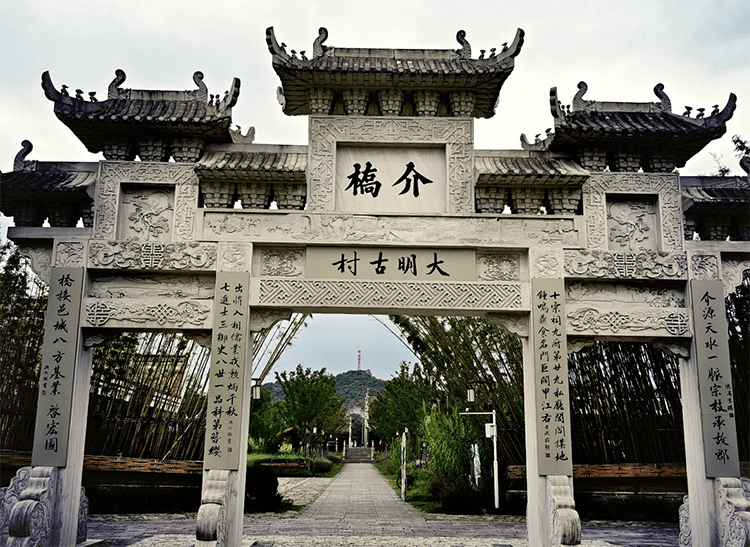Jieqiao Ancient Village – Yan Song Birthplace: Explore Ming-Qing Heritage & Four Wonders
Introduction
The blackened horse‑head walls reflected in the twin wells, square bamboo brushing against a Ming‑dynasty stone inscription — Jieqiao Ancient Village is a quietly preserved secret of western Jiangxi. With some 900 years of history, this rural hamlet tells the story of Yan Song’s family legacy. Walking its stone‑paved lanes, you’ll encounter imperial examination lore at every turn and the village’s famed natural “Four Wonders”: square bamboo, solid bamboo, dual‑temperature wells, and extraordinary rocks and trees. It’s both a living museum of Ming‑Qing life and a peaceful escape for urban travelers seeking poetry and history.
1. Soul Snapshot: Yan Song’s Hometown, Ming‑Qing Architecture Museum, and the “Four Wonders”
In one sentence, Jieqiao is “a rural memory carrier of Ming‑dynasty political power.” As the birthplace of Yan Song, the powerful yet controversial Grand Secretary under the Jiajing Emperor, the village preserves classic Ganxi (western Jiangxi) architecture while offering rare ecological curiosities that change expectations about what an “ancient village” can be. Listed among China’s traditional villages in 2013, its value lies not only in over 60 well‑preserved Ming and Qing houses but in the way political history, architectural craft, and natural wonder concentrate in a single landscape.
2. Historical Depth: From Northern Song Settlement to a Cradle of Power
• A millennium of continuity and the rise and fall of the Yan family
Founded in 1086 during the Northern Song, Jieqiao was home to the Yan clan for centuries. The family residence Ruizhu Hall witnessed the studious youth of Yan Song. Carved door lintels at the Yan ancestral hall, and stone inscriptions on Hanlin Bridge, recall the family’s imperial‑exam successes — once “five jinshi in a single generation” — and its turbulent political fortunes.
• Ganxi wisdom encoded in local architecture
The surviving grey‑brick houses adhere closely to Ganxi building conventions: tall horse‑head walls for fire and wind protection, interior courtyards arranged around the “four waters returning to the hall” feng shui principle, and decorative wood and stone carvings. Note the Yan family code engraved near the ancestral hall: a surprising contrast, given Yan Song’s controversial legacy, where “honor and integrity” appear as ancestral precepts.

3. Natural Wonders: Decoding Jieqiao’s “Four Wonders”
• Square bamboo and solid bamboo
In the courtyard of Ruizhu Hall grows a cluster of square‑section bamboo — a botanical oddity long regarded locally as an auspicious sign coinciding with Yan Song’s academic success. Behind the village, stands of solid bamboo — with culms lacking the usual hollow — have drawn botanists intrigued by their unique anatomy.
• Twin wells and yin‑yang balance
Two ancient wells sit side by side in the village center. One remains cool year‑round while the other feels slightly warm; locals call them the “yin‑yang springs.” Geologists suspect an underground stream split as the cause, while villagers treat the wells as a metaphor for the Yan family’s intertwined fortunes.
• The millennia‑old Luohan pine and turtle‑shaped stone
An over‑1200‑year‑old Luohan pine still thrives, its canopy sheltering the settlement like a ceremonial canopy. A naturally formed turtle‑shaped rock by the stream rises in a noble pose, echoing feng shui beliefs that a “spirit turtle calms the waters.”
4. Deep Experiences: Ways to Travel Through Time
• Cultural immersion route
Allow 3–4 hours to follow the core route: Yan Song’s Residence — Ancestral Hall — Hanlin Bridge — Old Opera Stage. Highlights include the Ming stone plaques at Ruizhu Hall and the original “Fenyi Yan clan genealogy” housed in the ancestral hall. If you visit in early spring near Qingming, you may witness the Yan descendants’ ancestral rites — a rare cultural moment.
• Nature and photography route
Photographers should arrive at dawn to capture the horse‑head walls reflected in the mist above the twin wells. In autumn, the Luohan pine glows against sunset skies for spectacular shots. A gentle 1.5‑kilometer bamboo trail behind the village is perfect for a short hike; look for ancient poems carved into bamboo nodes by past visitors.

5. Practical Guide: Getting There and Helpful Tips
• How to get there
By car: about 2 hours from Nanchang Changbei Airport via the Daguang Expressway. By public transport: take high‑speed rail to Xinyu North Station, then transfer to the Fenyi County tourist shuttle (four daily departures, about 40 minutes). Free parking is available at the village entrance.
• Tickets and opening hours
Admission RMB 60 (includes a special exhibition at the Yan ancestral hall); students half price. Open 08:30–17:30. No reservation is required, but avoid China’s National Day holiday when daily visitors may exceed 3,000. English audio guides require a one‑day advance phone reservation.
• Food and lodging
The village restaurant Fangzhu Family serves authentic Ganxi dishes; try Fenyi spicy duck and tofu made with well water. For an overnight experience, several restored Qing‑era houses operate as guesthouses (roughly RMB 200/night); facilities are rustic and bathrooms are basic.
Conclusion
Jieqiao Ancient Village reads like a three‑dimensional history book of brick, bamboo, and inscription. Yan Song’s life here is stripped of caricature and reappears as ancestral rules on lintels and the whisper of bamboo leaves. When the city noise gets overwhelming, come trace the grooves of the millennium‑old Luohan pine and listen to the twin wells’ story of balance. This living village awaits the footsteps that will measure its every historic contour.


